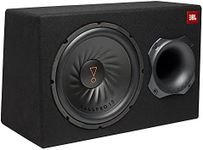Buying Guide for the Best Jbl Subwoofers
When it comes to picking the right JBL subwoofer, it's important to understand the key specifications that will impact your listening experience. Subwoofers are designed to enhance the low-frequency sounds in your audio, providing depth and richness to music, movies, and other audio content. By understanding the key specs, you can choose a subwoofer that best fits your needs and preferences.Power Output (Wattage)Power output, measured in watts, indicates how much power the subwoofer can handle and how loud it can get. Higher wattage generally means more powerful and impactful bass. Subwoofers with lower wattage (100-300 watts) are suitable for smaller rooms or less intense bass needs. Mid-range wattage (300-600 watts) is ideal for medium-sized rooms and balanced bass performance. High wattage (600+ watts) is best for large rooms or for those who want very powerful bass. Consider your room size and how much bass impact you desire when choosing the wattage.
Frequency ResponseFrequency response refers to the range of frequencies the subwoofer can reproduce, measured in Hertz (Hz). A wider frequency range means the subwoofer can produce both very low and relatively higher bass sounds. Typical subwoofers have a frequency response range of around 20-200 Hz. If you want deep, rumbling bass, look for a subwoofer with a lower minimum frequency (e.g., 20-30 Hz). For general use, a standard range will suffice. Your choice should depend on the type of audio content you listen to and how much depth you want in your bass.
Driver SizeThe driver size, measured in inches, refers to the diameter of the subwoofer's speaker cone. Larger drivers (10-15 inches) can move more air and produce deeper bass, making them suitable for larger rooms or for those who want a more immersive experience. Smaller drivers (8-10 inches) are more compact and can still provide good bass for smaller spaces. Choose a driver size based on your room size and how much space you have for the subwoofer.
Enclosure TypeSubwoofers come in different enclosure types, such as sealed, ported, and bandpass. Sealed enclosures provide tight, accurate bass and are generally more compact, making them suitable for music lovers who prefer precision. Ported enclosures have a vent or port that enhances bass output, making them louder and more efficient, ideal for home theater systems. Bandpass enclosures are designed for maximum output and are often used in car audio systems. Consider the type of audio content you will be using the subwoofer for and choose the enclosure type that best matches your needs.
Connectivity OptionsConnectivity options refer to how the subwoofer connects to your audio system. Common options include wired connections like RCA or speaker-level inputs, and wireless options like Bluetooth or Wi-Fi. Wired connections generally provide more stable and higher-quality audio, suitable for home theater setups. Wireless options offer more flexibility in placement and are easier to set up, ideal for those who want a clutter-free environment. Choose the connectivity option that best fits your existing audio system and your preference for setup convenience.











